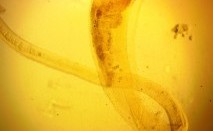
Category: Invertebrates
Crinoids, aptly nicknamed “feather stars”, can inhabit a wide range of marine environments and, judging by the fossil record, were very abundant organisms in the past, especially in the mid- to late-Paleozoic. They usually have a stem to attach themselves to a substrate but many only live attached as juveniles and spend most of their lives as free-swimming entities. They obtain nutrition by filtering small particles of food from the water using the mucous covered tube feet covering their feathery arms. Though they display the five-fold symmetry typical of echinoderms, some crinoids can have as many as two hundred arms!

Rub some dirt on it!
Could it be we have been too good at ridding our bodies of parasitic worms? Believe it or not, our efforts at keeping squeaky-clean and sanitary in the developed world may be contributing to increased allergies, asthma, psoriasis, even autoimmune diseases. The human immune system, having evolved with parasitic worms, recognizes them, and has learned to reduce inflammation and stimulate healing when these tiny intruders are sensed. While getting worms may be seen as too high a price to pay for many, for people suffering from severe allergies or colitis, it may be worth it. Victims of multiple sclerosis and Crohn’s disease have shown a promising reduction in symptoms (even remission in Crohn’s) after ingesting whipworm eggs - a treatment that may be worth it to some until a cure is found!
Learn more >>
 Discover Animals is a web-based educational resource offered by the NAIA
Discover Animals is a web-based educational resource offered by the NAIA